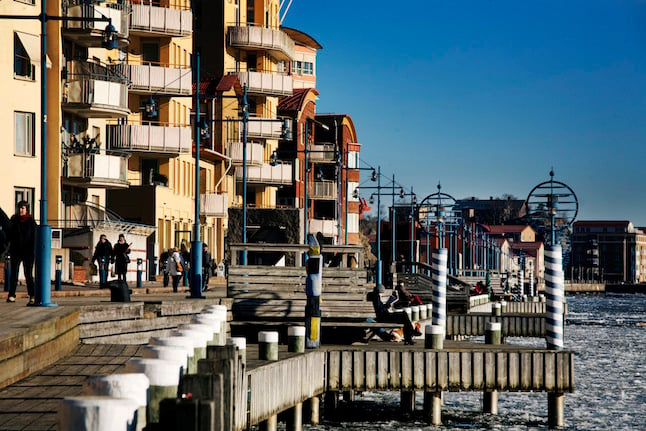First of all: where to look? The city of Gothenburg suggests on its website that sublets, houses and townhouses to rent all across West Sweden can be found on Blocket, a popular digital marketplace (in Swedish).
Other alternatives for rentals include the sites Bostaddirekt, Residensportalen and Findroommate, as well as Swedish websites like Hyresbostad and Andrahand. Note that some of the housing sites charge a subscription or membership fee. There are also Facebook groups where accommodation is advertised. An example in English is Find accommodation in Goteborg!.
If you’re buying, most apartments and houses for sale in Gothenburg and West Sweden can be seen on the websites Hemnet and Booli. Local newspapers often have property listings. Real estate agents (mäklare) can also help you find a place.

Majorna
Majorna is a residential area in Gothenburg that has transformed from being a classic working-class district to becoming a hip and restaurant-dense cultural hub in Gothenburg. The buildings typical for Majorna are three storey buildings with the first storey built in stone and the topmost two built with wood — the houses traditionally called Landshövdingehus. This neighbourhood just west of the city center, beautifully positioned between the river Göta älv and the park Slottsskogen, is hugely popular with young families.
Majorna was traditionally populated with industrial workers and dockers. The area is still supposed to have a strong working-class identity, with many people living in Majorna seeing themselves as radical, politically aware, and having an ‘alternative lifestyle’.
This doesn’t mean, however, that one can live in Majorna on a shoestring. The average price per square meter here is approximately 58,300 kronor as of June 2023, according to Hemnet.

Hisingen
From the centre of Gothenburg it’s only a short bus or tram ride across the river to Hisingen. It’s Sweden’s fifth largest island – after Gotland, Öland, Södertörn and Orust – and the second most populous. Hisingen is surrounded by the Göta älv river in the south and east, the Nordra älv in the north and the Kattegat in the west.
The first city carrying the name Gothenburg was founded on Hisingen in 1603. The town here, however, was burned down by the Danes in 1611 during the so-called Kalmar War and the only remnant is the foundation of the church that stood in the city centre.
Hisingen housed some of the world’s largest shipyards until the shipyard crisis of the 1970s. Over the last 20 years, the northern bank of the Göta älv has undergone major expansion. Residential areas, university buildings and several industries (including Volvo) have largely replaced the former shipyards.
Hisingen comprises many different neighbourhoods — Kvillebäcken, Backa and Biskopsgården are only some examples. At Jubileumsparken in Frihamnen, an area bordering the Göta älv, there is a public open-air pool and a spectacular sauna. Further inland you’ll find the beautiful Hisingsparken, the largest park in Gothenburg.
Apartment prices are still relatively low in certain parts of Hisingen, while the housing market in other neighbourhoods is booming. The average metre-squared price on Hisingen lies around 43,000 kronor.
Gamlestaden
Gamlestaden or the Old Town was founded as early as 1473, 200 years before Gothenburg’s current city centre was built. You can take a seven-minute tram ride towards the northeast to this upcoming district (popularly known as ‘Gamlestan’) which, like Majorna, is characterised by the original Landshövdingehus in combination with an international atmosphere.
What was once an industrial centre, mostly the factory of bearing manufacturer SKF, is now rapidly turning into something new, as restaurants and vintage shops move into the old red-brick factory buildings.
The multicultural neighbourhood is also close to the famous Kviberg’s marknad (market) and Bellevue marknad, where you can buy everything from exotic fruits and vegetables to second-hand clothes, electronics and curiosa.
The Gamlestaden district is developing and should become a densely populated and attractive district with new housing, city shopping and services. In the future, twice as many inhabitants will live here compared to today, according to Stadsutveckling Göteborg (City development Gothenburg). Around 3,000 new apartments should be built here in the coming years. The current price per metre squared in Gamlestaden is 46,500 kronor.

Skärgården
It might not be the most practical, but it probably will be the most idyllic place you’ll ever live in: Gothenburg’s northern or southern archipelago (skärgården). With a public bus or tram you can get from the city centre to the sea and from there, you hop on a ferry taking you to one of many picturesque islands just off the coast of Gothenburg.
There are car ferries from Hisingen to the northern archipelago. Some of the islands here are also connected by bridges. The southern archipelago can be reached by ferries leaving from the harbour of Saltholmen.
Gothenburg’s southern archipelago has around 5,000 permanent and another 6,000 summer residents. The archipelago is completely car free and transportation is carried out mostly by means of cycles, delivery mopeds and electrical golf carts.
Most residences here are outstanding — wooden houses and cottages, big gardens — and always close to both nature and sea. Finding somewhere to live, however, is not necessarily easy. Some people rent out their summer houses during the other three seasons. When buying a house here (the average price being upwards of 5 million kronor) you have to be aware that living in a wooden house on an exposed island often comes with a lot of renovating and painting.



 Please whitelist us to continue reading.
Please whitelist us to continue reading.
Member comments